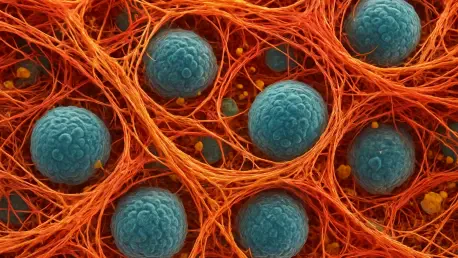What lies at the heart of life’s intricate design, shaping everything from a single cell to the complex tissues of the human body? The answer may surprise many: it’s not just the cells themselves, but the unseen network surrounding them, known as the extracellular matrix (ECM). This dynamic web of proteins and molecules acts as both a scaffold and a conductor, orchestrating how tissues grow and organs form. Far beyond a passive structure, the ECM holds secrets to developmental mysteries and medical breakthroughs, captivating scientists worldwide. This exploration delves into the profound influence of the ECM, revealing why it’s becoming a cornerstone of modern biomedical research.
Why the ECM Is Life’s Hidden Architect
The ECM might not be visible to the naked eye, but its impact on life is monumental. Often overlooked, this matrix provides the physical framework that supports cells, guiding their arrangement and behavior during the critical stages of growth. Research from leading institutions like the University of Rochester highlights that without the ECM’s precise mechanical cues, tissues could not develop into the specialized structures needed for organs to function. Its role is akin to an architect’s blueprint—essential, intricate, and indispensable for building life as we know it.
Understanding the ECM’s significance goes beyond academic curiosity; it’s a key to addressing some of humanity’s most pressing health challenges. From congenital defects affecting newborns to chronic conditions like cancer in adults, disruptions in the ECM are often at the root. With millions impacted by such conditions globally, the stakes couldn’t be higher. Groundbreaking studies, supported by substantial funding such as a $2 million grant from the National Institute of General Medical Sciences, are now shedding light on how this matrix influences cellular destiny, paving the way for revolutionary treatments.
The High Stakes of ECM Research in Today’s Science
Deciphering the ECM’s dynamics isn’t just a niche scientific endeavor—it’s a pursuit with far-reaching implications for medicine. Developmental disorders, which often originate from early missteps in tissue formation, are a prime target for this research. Similarly, conditions like impaired wound healing and tumor growth later in life are tied to aberrant ECM behavior. Scientists argue that mastering these interactions could unlock therapies for millions, transforming how diseases are approached across the lifespan.
Funding and institutional support underscore the urgency of this field. Prestigious grants and initiatives, such as those backing studies at the University of Rochester, signal a global recognition of the ECM’s potential. Over the next few years, from 2025 to 2027, collaborative efforts are expected to accelerate, connecting laboratory findings to clinical applications. This momentum reflects a shared belief among researchers that the ECM holds answers to long-standing medical puzzles, making it a priority for modern science.
The ripple effects of these discoveries are already visible in emerging therapeutic strategies. For instance, biomaterials designed to mimic the ECM’s properties are being tested to enhance tissue regeneration in patients with severe injuries. Such innovations illustrate how fundamental research can translate into tangible solutions, offering hope to those grappling with conditions once deemed untreatable. The ECM, in essence, is becoming a bridge between basic science and life-changing medicine.
Exploring the ECM’s Complex Contributions to Tissue Formation
At its core, the ECM serves as a structural scaffold, anchoring cells in place while withstanding the mechanical stresses of growth. Its unique viscoelastic properties—combining strength with adaptability—allow tissues to endure strain and still evolve into specialized forms. This balance is critical during development, ensuring that organs like the heart or lungs take shape without collapsing under pressure, a phenomenon meticulously documented in developmental biology studies.
Beyond structure, the ECM actively communicates with cells through mechanical signals, such as tension or compression, often rivaling genetic instructions in influence. These environmental cues dictate how cells divide, migrate, or differentiate into specific types, shaping entire tissues. Cutting-edge research reveals that when these signals falter, the consequences can be dire, leading to malformations or disease, a finding that underscores the matrix’s role as more than just a passive backdrop.
This interaction isn’t one-sided; cells continuously reshape the ECM in response to its prompts, forming a dynamic feedback loop. Studies on model organisms like fruit flies demonstrate how this dialogue coordinates development across multiple tissue layers. Disruptions in this cycle are now linked to a spectrum of issues, from early developmental anomalies to cancers that hijack these processes later in life, highlighting the ECM’s enduring impact on health at every stage.
Voices from the Field: Breakthroughs in ECM Research
Leading the charge in this domain, Assistant Professor Marisol Herrera-Perez from the University of Rochester’s Department of Biomedical Engineering offers a striking insight: “The ECM isn’t merely a support system—it’s a responsive partner, constantly adapting to cellular needs in ways that still astonish us.” Her team’s pioneering work, funded by a Maximizing Investigators’ Research Award, employs optogenetic tools to manipulate proteins with light, allowing real-time observation of ECM interactions in fruit flies. These experiments are unveiling how subtle mechanical shifts can alter developmental paths.
Complementing these efforts, researchers like Sharmistha Saha emphasize the ECM’s dual ability to resist and yield to forces as a determinant of tissue outcomes. Their findings align with a growing consensus that the matrix’s adaptability is central to life’s complexity. By combining innovative technologies with traditional models, scientists are painting a clearer picture of how this hidden network operates, pushing the boundaries of what’s known about development.
The excitement in the field is palpable, as each discovery builds on the last. Teams across the globe are now racing to map the ECM’s influence with unprecedented precision, driven by the promise of translating these insights into medical advancements. These expert perspectives and technological leaps signal that the study of the ECM is entering a transformative era, poised to redefine understanding of tissue growth.
Harnessing ECM Insights for Research and Medical Innovation
The knowledge gained from ECM studies is already inspiring practical applications that could reshape healthcare. Researchers are leveraging advanced tools like optogenetics to dissect the matrix’s interactions with cells, offering clarity on mechanical signals that were once elusive. This precision, as demonstrated in Herrera-Perez’s lab, equips scientists with the means to study development in real time, a leap forward from older, less dynamic methods.
Targeting developmental disorders is another promising avenue, where early detection of ECM disruptions could lead to interventions before severe conditions emerge. Imagine diagnostic tools that identify matrix-related anomalies in embryos, enabling corrective measures at the earliest stages. Such strategies are under exploration, with the potential to mitigate lifelong health challenges through timely action.
In regenerative medicine, mimicking the ECM’s properties with biomaterials offers hope for repairing damaged tissues, particularly in wound healing. Meanwhile, insights into the matrix’s role in diseases like cancer are guiding therapies that interrupt harmful remodeling processes, aiming to halt progression by recalibrating mechanical cues. These approaches, rooted in current research, provide a roadmap for turning ECM discoveries into solutions that bridge laboratory findings with patient care.
Reflecting on the Journey of ECM Discovery
Looking back, the journey to uncover the ECM’s role in tissue growth stands as a testament to scientific perseverance. Teams like those at the University of Rochester, armed with innovative tools and substantial funding, tackled the enigma of how a seemingly passive matrix could wield such profound influence over life’s development. Their work illuminated the intricate dance between cells and their environment, revealing a partnership that shaped everything from embryonic stages to mature organs.
The revelations about the ECM’s dynamic nature shifted paradigms, moving it from the sidelines to the center of developmental biology. Each experiment, from optogenetic manipulations to mechanical analyses, added a piece to the puzzle, showing how disruptions in this matrix underpinned a range of health issues. These findings carved out new paths for understanding diseases that spanned generations, linking early anomalies to later-life conditions.
As this chapter closes, the focus turns toward actionable steps for the future. Continued investment in ECM research promises to refine diagnostic tools for congenital defects, while biomaterials mimicking the matrix hold potential for healing wounds and regenerating tissues. Moreover, targeting the ECM’s role in cancer offers a novel angle to curb disease progression. These next steps, built on past discoveries, aim to transform the hidden architect of life into a cornerstone of medical innovation, ensuring that the legacy of this research will benefit countless lives ahead.









